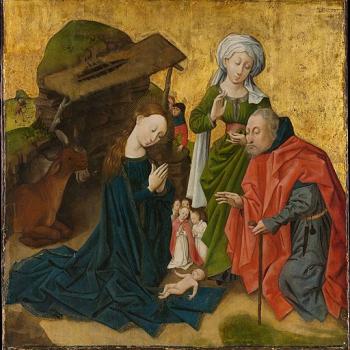Warning: this post is not terribly serious, and it gets a bit bawdy at the end. So if this is not to your taste, there is no need to read further.
This all started with an odd remark by my son Francisco. Sitting at the dinner table with my wife, Gabrielle, and I, he made some comment about “a picture of Jesus riding a dinosaur.” Now I had never heard of such a thing, but a quick Google search yielded several, including the following one:
Now we could have stopped and looked at the genesis (if you will pardon the pun) of such pictures, and perhaps even engaged in a bit of pop cultural analysis, as my son did before with his discussion of Dragon Ball Jesus. But the conversation didn’t go that way.
Instead, I mentioned that I had heard that there was a diorama of Adam riding a dinosaur at the Creation Museum in Kentucky. So we went looking for pictures of Adam and dinosaurs. We did not find him riding a dinosaur, but we did find one of Adam living peacefully with tyranosaurs:
There is also an nice interactive exhibit where your child can ride a saddled dinosaur:
(I cannot identify the species for certain, but it appears to be a juvenile triceratops or some other species in the family Ceratopsidae.)
But in the course of looking around on the Creation Museum web site, we first found their “medieval themed” Dragon Hall Bookstore, and this led us in turn to the More Fun For Kids page, which includes a discussion of the connection between dinosaurs and dragons. Here they mentioned the “description” of dinosaurs in the book of Job. To my surprise, my son immediately started to quote the passage describing Behemoth, but soon stumbled. So we went off to look it up, using an online version of the Bible from Bible Gateway. From the NIV we read
Look at Behemoth,
which I made along with you
and which feeds on grass like an ox.
What strength it has in its loins,
what power in the muscles of its belly!Its tail sways like a cedar;
the sinews of its thighs are close-knit.
Its bones are tubes of bronze,
its limbs like rods of iron.Job 40:15-18
At this point my wife chimed in, asking about verse 17: “the sinews of its thighs are close-knit.” This struck her as odd, and she wanted to know what this was about. I suggested we look up the meaning of the underlying word, so it was off to the Blue Letter Bible, another online biblical resource that includes interlinear Greek and Hebrew, with links to the respective lexicons. Here things got interesting, because the default English translation it uses is the King James Bible, which translates verse 17 as
He moveth his tail like a cedar: the sinews of his stones are wrapped together. (emphasis added)
We were confused: how did the same word get translated as “thighs” and “stones”? And did “stones” refer to what we think it did? My wife certainly thought so: and she pointed to the parallelism with the previous verse which refers to “loins”. The underlying Hebrew is dubious. The link to Strong’s concordance (H6344) said the Hebrew is transliterated as “Pachad” and means “thigh.” It refers to a closely related word (H6343) that is translated as “terror” or “dread”. (The Hebrew script looks nearly the same: I think it only differs in diacritical marks, but I am no expert.) However, there is also a definition from Gesenius’ Hebrew-Chaldee Lexicon which starts with the Latin words “verenda” (dreadful) and “pudenda” (external male genitalia). But then there is an addition in square brackets that says
Taken in Thes. in this place to mean “thighs”.
According to study notes provided by Blue Letter Bible, these notes were added by a later editor, Tregelle, to correct Genesius’ “rationalism.” I have not been able to confirm the meaning of the abbreviation “Thes.”: my first guess was Thessalonians, but that did not yield anything useful.
But what we saw is that the KJV and a 19th century German philologist took this word to mean male genitalia, and that this word only appears here in the standard Hebrew text of the Old Testament. Words that mean “thigh” or “thighs” appear multiple times in the OT: for instance, Daniel 2:32, where the underlying Hebrew word is transliterated as “yarka'” and translated as “thighs”.
So what about other translations? So back to the Bible Gateway, which has a number of other texts available. Every English text we consulted had “thighs” except the KJV and the Wycliffe bible, both of which had “stones”. Since the Wycliffe bible was translated directly from the Vulgate, we pulled up the Latin text, which translates this as “nervi testiculorum”: the nerves or sinews of his testicles. Now, out of curiosity, I wanted to see what the Septuagint has for this passage. The Blue Letter Bible gives the text of the LXX, but does not do an interlinear translation of the Greek for the OT, only the Hebrew So off to the internet to find an interlinear LXX.
After a couple of false starts, we found The House of the Messiah: I think this is a group of Messianic Jews, but they do provide an interlinear Old Testament with Hebrew, Greek and English. (I ignored their other content and hoped they provided an accurate scholarly source.) We found that there is a curious gap in the LXX: the text appears to read that his “nerves are knit together”. Testicles/stones/thighs seem to have been omitted.
So what to make of this passage? My wife made another trenchant point: the first part of the verse refers to the “tail” of Behemoth. But when looking at the other English translations of this verse, we saw thatt the KVJ and NIV both talk about “moving” or “swaying”, but several other translations, such as the RSV, translate this as “stiffening his tail”. If we couple this with the fact that at least some people have read the second part as referring to testicles, it would seem that the first part might well be referring to his penis.
At this point the conversation broke down in general hilarity. But as I was typing this up, I did a little more searching. At least one other person has come to the same conclusion. Mark Edwards (markedwards) had a long post on BibleForums Christian Message Board about this passage. His main purpose was to argue (contra creationists) that this passage did not refer to a brontosaurus but rather was about a hippopotamus. But he begins his post with a “maturity warning” because as one of his arguments he writes:
Seventh. However (and here comes the “mature” part), another issue seems to be that “tail” is not the best interpretation of the Hebrew text. Before we directly address that, let’s first turn to the second line of the text: “the sinews of his thighs are knit together”. What the ESV gives here as “thighs”, is the Hebrew word pachad. It means “testicle”, “as a cause of shame” [Mickelson].
Now, there is a common aspect of Hebrew poetry we recognize as parallelism. Meaning, two consecutive lines in a poem or poetic statement contain the same message. That is, Line 1 gives such-and-such statement, and Line 2 repeats it in another way. We find this parallelism evident in the preceding and following verses of Job 40.17. Verse 16 contains two parallel lines that describe the behemoth’s bodily strength, and verse 18 contains two parallel lines that describe the behemoth’s limbs.
Verse 17 also contains parallelism. The second line of this verse refers to the behemoth’s testicles. (The KJV renders it as “stones”…) As such, we should expect that the first line contain a parallel element, which the Hebrew calls the “tail”. Biologically, what element of the (male) body is parallel to the testicles? It appears, then, that the Hebrew is calling this male appendage a “tail” only in euphemism. (Deuteronomy 23.1 calls this male appendage a “pipe” in euphemism.)
Eighth. Lastly, there is a particular verb at issue in verse 17, the Hebrew chaphets. In every other instance in the Bible, this verb translates to “delight” or “pleasure” or something related. In this one case, for no reason at all, most English translations give it as “to move” or “to bend”.
To recap the previous points: The second line of verse 17’s parallelism directly refers to the behemoth’s testicles. The first line refers to a “tail”-like appendage that, as we see here in Point 8, is a “delight” to the behemoth; a “tail”-like appendage that becomes stiff like a cedar tree.
In no way to be crude, but I think it’s obvious that what is being described to us, this “tail”-like appendage, which is parallel to the testicles, which the behemoth takes “pleasure” in, is not really a tail.
I am no scripture scholar, but this seems to be a pretty reasonable reading, particularly since there are other passages in the OT that are on the earthy side, and cover it with various euphemisms.
So my question, for any better informed readers, is this: is this a correct reading of the passage. And if so, how did it come about that the Hebrew Pachad came to be translated as “thighs” rather than as “testicles”?
A broader question is why bowdlerize scripture in this fashion? Why do we try to avoid confronting the earthy, often frankly sexual imagery used, particularly in the OT?














